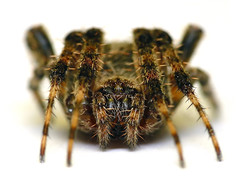 click for large
click for largeThe Common Barn Spider (Araneus cavaticus) is a nocturnal, black and brown spider with striped legs. They also have markings on their underside that are typically a black background with two white marks inside the black, although color ranges can be quite magnificent. The photo above shows the classic pose these spiders exhibit, with the front four legs grouped together, and the back legs tucked similarly. They will sit quite still for pictures in this pose, but trust me, if you bump the table they will pop up and run like lightning!
Like many other species of orb weavers, it takes down its web and rebuilds another web every evening. Its "orb" web is the archetypical web that contains symmetrical spokes connected by a spiral inside. They hide during the day and at night will sit in the middle of the web and wait for an insect to land on the web when hunting.
These spiders are aggressive toward each other (and toward humans). They will attack each other if in close quarters, though many may inhabit the same structure or area at any given time. They are most commonly found in rafters and wooden structures in suburban and rural structures or areas, and on boats near lakes, thus getting their name, "barn spider".
They are mostly found in North America in late summer and through autumn. Barn spiders are most common in the Northeast US and Canada.
When agitated (by a puff of air, for instance) these spiders sometimes bounce up and down in the center of their webs, possibly in an attempt to look larger and more threatening.
Raynox DCR-150
i just spent half an hour watching a female of this species take its web down and rebuild it. i really appreciate that you took the time to take this photo and add info as well. thank you.
ReplyDeleteI've been told by many people that this spider is venomous, but so far the only information I've gotten was the same as what you'd posted. Can you possibly help me out on figuring out whether or not they are?
ReplyDeleteAs pretty much every spider alive, they are venomous. Whether the venom effects humans or not is the question. For this spider, no. Their venom doesn't present a problem for humans.
ReplyDeleteYou may get a red itchy bump, if you could get it to bite you, but that's about it. It would take a lot for it to bite you though, like holding it in your hand and trying to squish it.
Venom is a precious resource to venomous creatures. It takes an intensive metabolic process to make it. As such, they like to not use it if at all possible. I've handled hundreds of spiders in the wild and none has ever bitten me.
I have a very large barn spider living outside a window at my home. What will happen to it when the weather changes and gets cold?
ReplyDeleteIt will die. No worries though, it has probably already made an egg case and stashed it away. There will be hundreds emerging from it next spring if they're lucky.
ReplyDeleteThank you for your lovely work! Thanks to this photo, I was able to identify the spider found outside my house this afternoon (I live in Minneapolis).
ReplyDeleteOn a sidenote, I use an FZ7 and have to thank you for proving that you don't need an extra-fancy camera for great macro shots!
You are very welcome! I have found the Panasonic Lumix cameras very adept.
ReplyDeletehow do i get it out of my house?????
ReplyDeleteHello, I've found a spider quite recently living in an old grill that I had stored away. I opened it up, and found him, or her. I'd like to know what kind it is.
ReplyDeleteHere it is https://m.facebook.com/#!/photo.php?fbid=253363581469636&id=100003879874069&set=a.107772672695395.9409.100003879874069&__user=100003879874069
ReplyDeleteHow do you get rid of these barn spiders? I am thinking it comes into the bathroom through the heating/cooling vent.
ReplyDelete